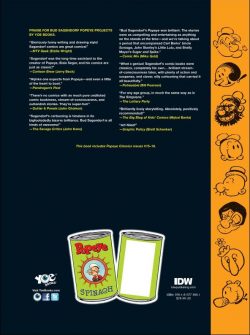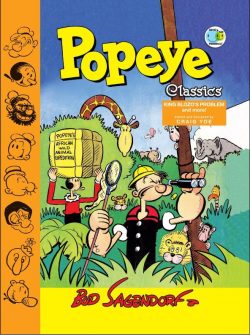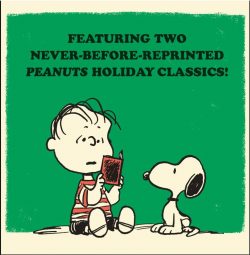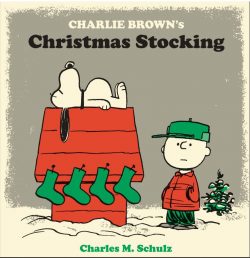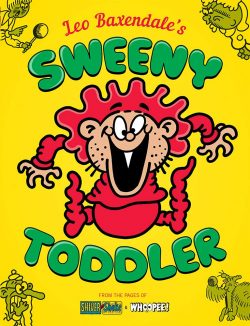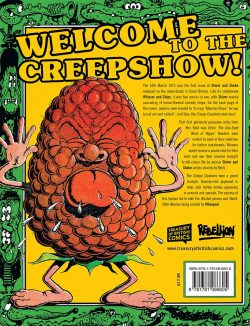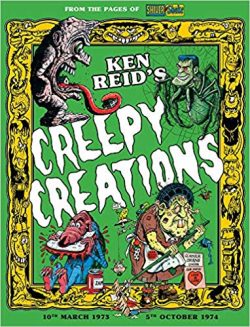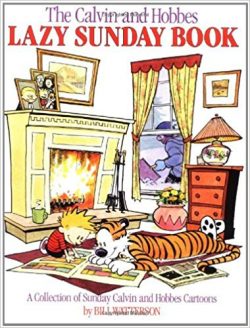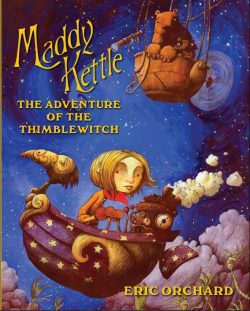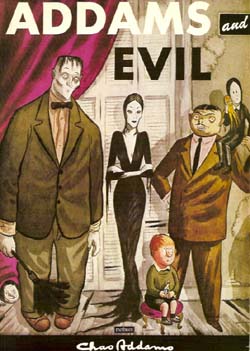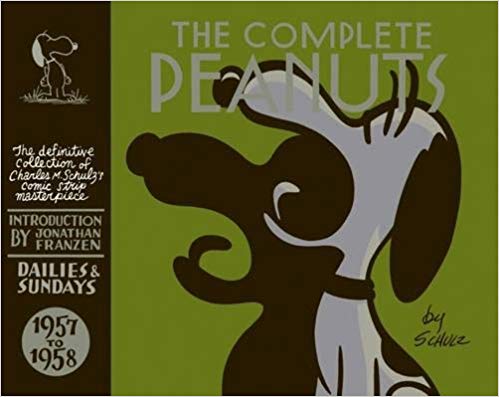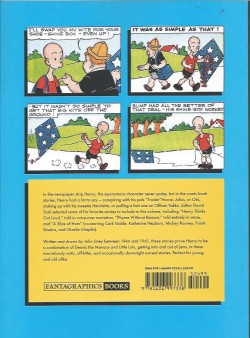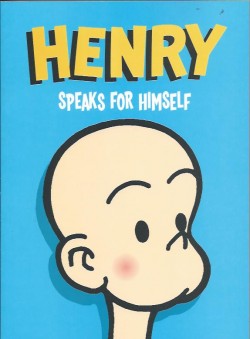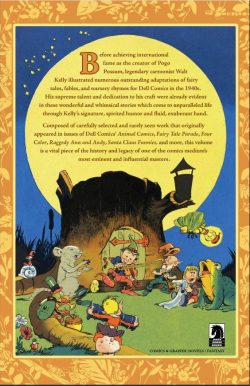
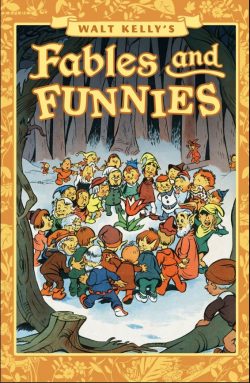
By Walt Kelly, compiled by David W. Tosh (Dark Horse Books)
ISBN: 978-1-61655-905-2 (HB) eISBN: 978-1-63008-595-7
Win’s Christmas Gift Recommendation: Unmatched Imagination and Timeless Treasures… 10/10
Justifiably revered for his brilliant newspaper strip Pogo, and his wonderful Our Gang tales, the incredible Walt Kelly also has a pretty strong claim to owning the traditional childhood Christmas. From 1942 until he abandoned comic-books for newsprint in 1949, he crafted stories celebrating the season of Good Will (and other yearly milestones such as Easter) for West Coast printing giant Western Printing & Lithographing who subcontracted their comic books to publisher Dell.
Santa Claus Funnies and Christmas with Mother Goose were Holiday institutions in both their Four Color and Dell Giant incarnations, with the sheer beauty and charm of Kelly’s work defining what Christmas should be for two generations. His prodigious talents served to preserve and further the classic traditions of fairy tale and fable illustration in those years.
Kelly transferred his affinity for the best of all fantasy worlds to the immortal Pogo but still was especially associated with the Festive season. Many publications sought out his special touch. Even the Christmas 1955 edition of Newsweekstarred Kelly and his cartoon cast on the cover.
Walter Crawford Kelly Jr. was born in 1913 and began his cartooning career whilst still in High School as artist and reporter for the Bridgeport Post. In 1935 he moved to California and joined the Disney Studio, working on animated short films and such features as Dumbo, Fantasia and Pinocchio.
His steady ascent was curtailed by the infamous aforementioned animator’s strike in 1941. Refusing to take sides, Kelly quit, moving back East and into comicbooks – primarily for Dell who held the Disney rights license amongst many other popular properties – at that time.
Despite his glorious work on major mass-market, people-based classics such as the Our Gang spin-off, Kelly preferred and particularly excelled with anthropomorphic animal and children’s fantasy material.
For December 1942-released Animal Comics #1 he created Albert the Alligator and Pogo Possum, wisely retaining the copyrights to the ongoing saga of two affable Bayou critters and their young African-American pal Bumbazine. Although the black kid soon disappeared, the animal actors stayed on as stars until 1948 when Kelly moved into journalism, becoming art editor and cartoonist for hard hitting, left-leaning liberal newspaper The New York Star.
On October 4thth 1948, Pogo, Albert and an ever-expanding cast of gloriously addictive, ridiculously exuberant characters began their strip careers, appearing in the paper six days a week until the periodical folded in January 1949.
Although ostensibly a gently humorous kids feature, by the end of its New York Star run (reprinted in Pogo: The Complete Syndicated Comic Strips) the first glimmerings of an astoundingly barbed, boldly satirical masterpiece of velvet-pawed social commentary had begun to emerge…
In this superb hardback and digital collection – offering vintage delights from Animal Comics #1, 21, 22, 28 and 30 (1942-1947), Fairy Tale Parade #7 (1943), Four Color #59, 87, 103 (Easter With Mother Goose) and 253 (Christmas With Mother Goose) which span 1944-1949 plus material from Our Gang with Tom and Jerry #45 (1948), Raggedy Ann and Andy #3, 5, 8, 9, 14, 16, 19, 20, 25, 26, 28 and 30 (1946-1948) and Santa Claus Funnies (1942) by Dell Publishing Co., as well as March of Comics #3 from 1947 – we can revel in his boundless charm and visual mastery again.
Augmented by sublime original artwork pages, this superb funfest opens with an appreciative preface by compiler David W. Tosh and Introduction ‘Walt Kelly’s Western Adventures’ by John E. Petty which outlines Kelly’s career and clarifies the odd relationship of Western and Dell.
None too soon we’re frolicking amidst the wondrous realms of fairies, elves, giants and talking beast as First Chapter Flights of Fancy opens with a 1946 yarn from Animal Comics #21. ‘Prehysteria with Koko’ is a smart and sassy romp as a caveboy toddler, his dog and a missing link go hunting, after which a band of otherworldly cherubs befriend an insignificant and affable wyrm and help out against a bullying giant in ‘Tiny Folk and the Dragon (Four Color #87, 1945).
Puckish pixies ‘The Brownies’ (Raggedy Ann and Andy #30, 1948) then pay for their scandalous attempts to pilfer a fresh-baked pie before a smart little girl shows up all the cowardly town adults and captures a sneaky band of bandits in ‘The Dragon of Dilly Dun Dee’ (Fairy Tale Parade #7, 1943): a wild and funny romp that really should have been an animated feature…
The focus switches to Animal Pals next as fauna foul and friendly entertain and educate, beginning with ‘Muzzy and Ginger’ (Animal Comics #1, 1942) as a chimp and a kitten strike up a unique and disaster-prone friendship when they are delivered to a city pet shop, whilst equally odd couple ‘Nibble and Nubble’ (Animal Comics #28, 1947) add a new spin to the legendary dynamic of cat vs mouse…
Worldly-wise mouse ‘Nibble’ (Animal Comics #30, 1947) then goes solo and outwits smug fellow housemates Dog and Parrot before ‘Elephunnies’ (Animal Comics #22, 1946) takes us to the jungle for an explosive slapstick riot of soundless comedy pranks.
Wrapping up the chapter, ‘Chippie’ (Raggedy Ann and Andy #30, 1948) reveals how an old owl helps a bullied, harried chipmunk save his cached winter reserves from a thieving blue jay…
Mother Goose gets her own chapter for a celebration of a lost art next, with Kelly combining hilarious visuals with rhyming couplets and other informative doggerel in a remarkably popular and long-lived feature aimed at pre-schoolers and based on classic stories and nursery rhymes. The fairy tale procession begins with ‘Old Woman Tossed Up in a Basket’ and ‘The Owl and the Pussy-Cat’ (both from1944’s Four Color #59), followed by a non-stop parade of ‘Animal Mother Goose’ extracts from Raggedy Ann and Andy #3, 8, 9, 14, 16, 19, 20, 25, 26 and 28 (1946-1948) including ‘Winter’, ‘The Carrion Crow’, ‘The Pig in the Wig’, ‘Humpty Dumpty’ and much, much more.
The Kids Know Best dips into Kelly’s glorious canon of Our Gang tales, with extended adventure plus a rowdy vignette.
Our Gang (later to be known as the Li’l Rascals) movie shorts were one of the most popular series in American Film history. Beginning in 1922, they featured the fun and folksy humour of a bunch of “typical kids†(atypically, though, there was full racial equality and mingling – but the little girls were still always smarter than the boys) having idealised adventures in a time safer, simpler yet more sinister.
The rotating cast of characters and slapstick shenanigans were the brainchild of film genius Hal Roach (he directed and worked with Harold Lloyd, Charley Chase and Laurel and Hardy amongst many others) and these brief cinematic paeans to a mythic childhood entered the “household name†category of popular Americana in amazingly swift order.
As times and tastes changed Roach was forced to sell up to the celluloid butcher’s shop of MGM in 1938, and the features suffered the same interference and loss of control that marred the later careers of the Marx Brothers, Laurel and Hardy and Buster Keaton.
In 1942 Dell released an Our Gang comic book written and drawn by Kelly who – consummate craftsman that he was – restored the wit, verve and charm of the cinematic glory days with a progression of tales that elevated lower-class American childhood to the mythic peaks of Dorothy in Oz or Huckleberry Finn.
Over the course of the first 8 issues the master raconteur moved beyond the films – good and otherwise – to build an idyllic story-scape of games and dares, excursions, adventures, get-rich-quick-schemes, battles with rival gangs and especially plucky victories over adults: mean, condescending, criminal or psychotic.
That certainly applies in lead story ‘Our Gang and the Old House Mystery’ (March of Comics #3, 1947) as some of the gang are abducted by criminals who have replaced good old Doctor Baxter after which an untitled short from Our Gang with Tom and Jerry #45, 1948) sees toddler tykes Anastasia and Toby innocently cause a storm of domestic mayhem when they secretly raid the refrigerator…
Almost as big a deal as Christmas back then, Searching for the Easter Bunny then curates a selection of lively yarns taken from Four Color #103 as Easter With Mother Goose opens eponymously with a pictorial treat describing the kids of Nursery Rhyme land preparing their egg gifts even as ‘Peter Peter Pumpkin Eater’ offers sage storage advice and a search for the Easter Bunny ‘Through the Town’ proves fruitless.
‘Humpty Dumpty and the Giant’ reverts to strip form as the hapless ovoid innocent narrowly avoids being consumed by Reynard Fox only to be whisked away up a beanstalk to the clouds…
A trainee Easter Bunny’s first delivery goes awry but is fixed thanks to kindly assistance from chickens and ducks in ‘Buddy Bunny’s Problem’ whilst ‘The Three Blind Mice and Their Easter Gift’ cheer up ailing Tommy Tucker before a return to rhyme reveals the poetic attrition rate of ‘Ten Little Easter Eggs’…
With best left ’til last, Finally, It’s Christmas celebrates the Season, beginning with a brace of tales from Four Color #253 (Christmas With Mother Goose 1949), opening with ‘Jeminy’s Christmas’ wherein eager lad Wee Willie Winkiecauses unintended chaos by waking up a hibernating groundhog three months early. At least befuddled Jiminy gets to enjoy his first Xmas and even meet jolly old St. Nick, whereas in ‘The Three Blind Mice Play Santa’, when the trio’s antics interfere with post to the North Pole the guilt-ridden pests move mountains to make good on the catastrophe and ensure all the kids get what they deserve…
Wrapping up the merriment ‘The Fir Tree’ is a potent yet jolly adaptation of one of Hans Christian Andersen’s lesser known and rather creepy fables. Here a tree in the forest yearns for the day when it’s cut down and he becomes something useful…
It absolutely baffles me that Kelly’s masterful Christmas tales (and Batman‘s too for that matter) are not re-released every November for the Yule spending spree. Christmas is all about nostalgia and good old days and there is no bigger sentimental sap on the planet than your average comics punter. And once these books are out there, their supreme readability will quickly make converts of the rest of the world.
I’ve been right before and one day I will be again… just you wait and see…
Walt Kelly’s Fables and Funnies: Dell Comics Stories 1942-1949 Preface © 2016 David W. Tosh. Introduction © 2016 David John E. Petty. All rights reserved.

